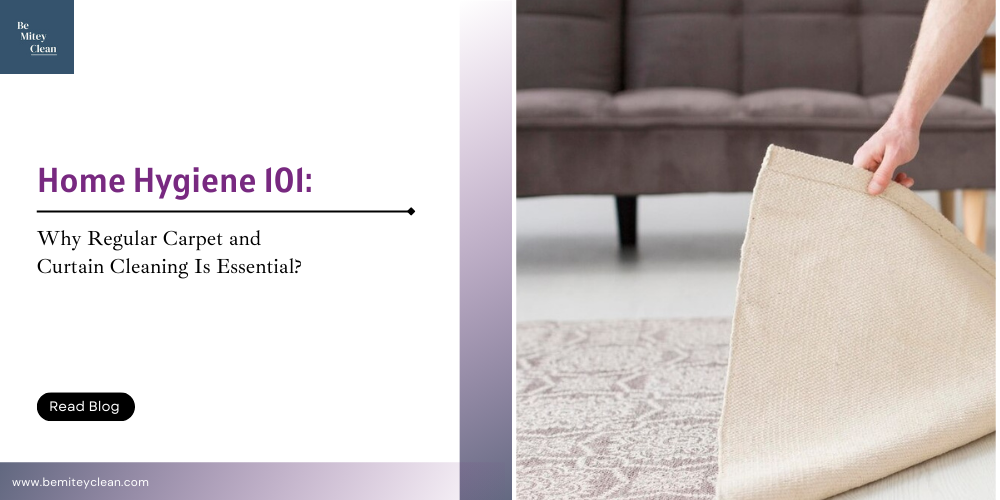Maintaining a clean home isn’t just about appearances; it’s about creating a healthy environment for you and your loved ones. While many focus on visible surfaces, there are often overlooked areas that play a crucial role in home hygiene – carpets and curtains. In this guide, we’ll delve into the importance of carpet & curtain cleaning and why these elements are essential for a healthier living space.
Hidden Culprits: Dust, Bacteria, and Mould
Dust mites, allergens, bacteria, and mould are the silent invaders that lurk within the fibres of your carpets and the folds of your curtains. Dust mites, microscopic creatures thriving in dust, can trigger allergies and respiratory issues. Bacteria find their way into carpets through various means, and mould can quickly develop in damp curtains, posing health risks to everyone at home.
Health Implications: Beyond the Surface
The consequences of neglecting carpet cleaning and curtain hygiene extend beyond a filthy appearance. Respiratory issues, aggravated allergies, and skin irritations can result from prolonged exposure to these hidden contaminants. Children and pets, with their sensitive immune systems, are particularly vulnerable, making regular maintenance a necessity.
Regular Maintenance Routine
Establishing a regular maintenance routine is paramount to safeguard your home against these unseen threats. Let’s break down the key steps to ensure your carpets and curtains remain clean and contribute to a healthier living environment.
A. Vacuuming Best Practices
- Frequency and Technique: Regular vacuuming is the first line of defence. Try to do it once a week or more, with an emphasis on crowded areas. To collect even the tiniest particles and stop them from recirculating into the air, use a Hoover cleaner with a HEPA filter.
- Importance of HEPA Filters: By capturing tiny particles, high-efficiency particulate air (HEPA) filters make sure that your hoover doesn’t unintentionally transmit allergies. Invest in a vacuum cleaner equipped with a HEPA filter for optimal effectiveness.
B. Professional Carpet Cleaning
- Benefits of Steam Cleaning: While routine vacuuming is essential, professional steam cleaning offers a deeper, more thorough cleanse. The heat from steam not only removes dirt and stains but also eliminates bacteria and allergens, leaving your carpets sanitised and refreshed.
- Choosing the Right Cleaning Products: When opting for DIY cleaning, choose products specifically designed for carpets. Read labels carefully, and test on inconspicuous areas first. Avoid harsh chemicals that can compromise indoor air quality.
C. Curtain Care
- Removal and Washing Guidelines: Curtains accumulate dust and odours over time. Remove them periodically for a gentle wash, following care instructions provided by the manufacturer. Be mindful of any special fabric requirements to maintain their integrity.
- Dry Cleaning vs. Machine Washing: To prevent shrinkage or colour fading, some curtains may require curtain dry cleaning. Others can be safely machine-washed. Know your curtain fabric and care instructions to choose the appropriate cleaning method.
DIY Cleaning Tips
After discussing the benefits of professional cleaning, let’s look at some do-it-yourself (DIY) methods for maintaining the finest possible condition for your curtains and carpets. These easy suggestions enable you to actively contribute to the creation of a healthy home environment in addition to assisting with cleaning.
A. Homemade Carpet Cleaners
- Vinegar and Water Solution: For spot cleaning, mix equal parts white vinegar and water. Dab the solution onto stains using a clean cloth or sponge, then blot with a dry cloth. The acidic nature of vinegar helps break down stains without leaving residue.
- Baking Soda and Essential Oils: Mix a small amount of your favourite essential oil with baking soda to create a DIY carpet cleaner. Spread the mixture thoroughly over the carpet, let it sit for at least fifteen minutes, and then give it a good hoover. This easy procedure efficiently neutralises undesirable odours and revitalises your carpet.
- Corn-starch for Greasy Stains: Corn-starch works wonders on greasy carpet stains. Sprinkle it over the affected area, let it sit for several hours, and then vacuum it up. The corn-starch helps absorb the grease, leaving your carpet cleaner.
B. Curtain Freshening Sprays
- Citrus and Water Mist: Create a refreshing curtain spray by mixing water with a few drops of citrus essential oil. Lightly mist your curtains and allow them to air dry. This not only adds a pleasant scent but also helps eliminate any lingering odours.
- Lavender Sachets: Make simple lavender sachets and place them near your curtains. Lavender not only imparts a delightful fragrance but also possesses natural antibacterial properties, contributing to a cleaner atmosphere.
C. Preventive Measures
- Use Doormats: Place doormats at entrances to minimise the amount of dirt and debris tracked into your home. This simple step significantly reduces the workload on your carpets.
- No Shoes Indoors: Enforce a no-shoes policy indoors to prevent outdoor pollutants from being carried onto carpets. This small lifestyle adjustment can make a significant impact on home hygiene.
- Regularly Rotate Furniture: Periodically rearrange your furniture to ensure even wear on carpets. This prevents excessive compression in certain areas and extends the lifespan of your carpet.
Extending the Longevity
A. Prolonging Carpet Lifespan
- Prevent Stains and Spills: Accidents happen, but taking precautions can minimise the impact. Use rugs in high-traffic areas and treat spills promptly to prevent stains from setting in.
- Rotate Furniture: Regularly change the layout of your furniture to distribute weight and foot traffic evenly across the carpet. This prevents certain areas from wearing out faster than others.
B. Curtain Maintenance Tips
- Sun Protection: Direct sunlight can fade and damage curtains over time. Use blinds or shades to shield curtains from prolonged exposure to sunlight. This simple step preserves their colour and fabric integrity.
- Proper Handling and Folding: When opening or closing curtains, handle them with care to avoid unnecessary stress on the fabric. Proper folding techniques during washing and storage prevent creases and maintain the curtain’s aesthetic appeal.
Overcoming Common Challenges
A. Dealing with Stubborn Stains
- Blot, Don’t Rub: When tackling stains, resist the urge to rub vigorously. Instead, blot the stain with a clean cloth or paper towel. Rubbing can spread the stain and damage the carpet fibres.
- Club Soda for Immediate Action: For spills, especially those involving red wine or coffee, immediately pour club soda into the affected area. The carbonation helps lift the stain to the surface for easier blotting.
B. Addressing Persistent Odours
- Baking Soda Overnight: To eliminate lingering odours in carpets, sprinkle baking soda liberally before bedtime. Let it sit overnight, then vacuum thoroughly the next day. Baking soda absorbs and neutralises odours effectively.
- Fresh Air Ventilation: Allow fresh air to circulate through your home regularly. Open windows and doors to promote ventilation, helping to disperse indoor odours and maintain a clean, fresh atmosphere.
C. Handling Fabric Specifics
- Read Care Labels: Before attempting any cleaning or maintenance, familiarise yourself with the care instructions on your curtains and carpets. Different fabrics have unique requirements, and following these guidelines ensures proper care.
- Test in Inconspicuous Areas: When using DIY cleaning solutions, test them in some small areas first to ensure they don’t cause discolouration or damage. This precautionary step avoids unpleasant surprises.
Investing in Hygiene
A. Cost-Benefit Analysis
Even though maintaining a clean home environment requires some time and effort, the benefits in terms of life and health are priceless. Whether done professionally or on your own, routine cleaning is a proactive investment in your family’s health and the aesthetic longevity of your house.
B. Long-Term Savings on Health Expenses
Consider the long-term savings on potential health expenses. A clean house lowers the chance of allergies, respiratory problems, and skin irritations, which improves quality of life and results in lower medical costs. You’re investing wisely in your current and long-term health when you put cleanliness first.
Conclusion
In our exploration of home hygiene, it’s clear that regular carpet cleaning and curtain cleaning are not merely cosmetic choices but essential practices for a healthy living space. From DIY cleaning tips to preventive measures and overcoming common challenges, taking a proactive approach to home maintenance pays off in the long run. As you embrace these practices, you’re not just cleaning – you’re investing in a healthier, happier home for you and your loved ones.
Related Reads: The Role of a Full-Time Maid in Elderly Care: A Comprehensive Guide



